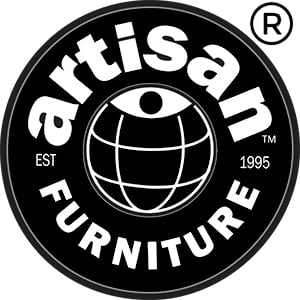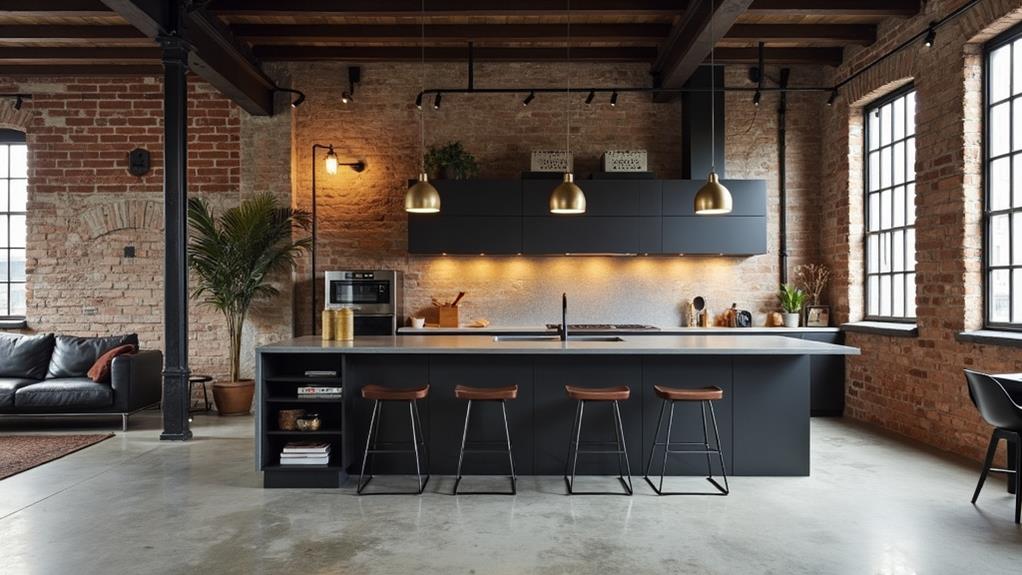The industrial aesthetic has profoundly shaped modern design trends, transforming spaces with its raw, utilitarian charm. You’ll find exposed structural elements, raw materials like metal and concrete, and vintage-inspired lighting fixtures as hallmarks of this style. It’s influenced home decor, workplace design, and furniture, emphasizing functionality and authenticity. The industrial look often blends with other styles, creating unique fusions that balance rugged textures with softer elements. As sustainability gains importance, the future of industrial design is evolving to incorporate eco-friendly materials and smart technology. Exploring this aesthetic further reveals its deep impact on contemporary spaces and its potential for continued innovation.
Origins of Industrial Design
The roots of industrial design stretch back to the late 19th and early 20th centuries, intertwined with the rapid industrialization and technological advancements of the era. You’ll find that this movement emerged as a response to mass production techniques, which demanded standardized, functional, and aesthetically pleasing products.
The Bauhaus school in Germany played a pivotal role, emphasizing the marriage of form and function in everyday objects. This emphasis on functionality led to the incorporation of raw materials like exposed brick, concrete, and reclaimed wood, which became hallmarks of the industrial aesthetic.
As you explore deeper, you’ll notice that pioneers like Peter Behrens, who worked for AEG, began applying artistic principles to machine-made products. This approach marked a significant shift from ornate, handcrafted items to sleek, utilitarian designs.
The industrial aesthetic gained momentum during the 1920s and 1930s, influenced by Art Deco and Modernism. You’ll see that the focus on materials like steel, glass, and concrete became prominent, reflecting the industrial processes of the time.
Designers began prioritizing ergonomics and efficiency, creating objects that were both practical and visually appealing. This era laid the groundwork for the industrial aesthetic that continues to influence modern design trends today.
Key Elements of Industrial Aesthetic
Characterized by its raw and unfinished look, the industrial aesthetic boasts several key elements that define its unique style. You’ll find exposed structural components, such as beams, pipes, and ductwork, prominently featured in industrial designs. These elements, often left bare or painted in muted colors, serve both functional and aesthetic purposes.
Materials play a vital role in this style. You’ll encounter an abundance of metal, particularly steel and iron, alongside weathered wood and distressed leather. Concrete floors and exposed brick walls are also common, adding to the utilitarian feel. The color palette typically consists of neutral tones, with occasional pops of rustic or muted colors.
Lighting in industrial spaces often incorporates vintage-inspired fixtures, like Edison bulbs or warehouse-style pendant lights. You’ll notice an emphasis on large, open spaces with high ceilings, reflecting the style’s origins in factories and warehouses.
Furniture tends to be practical and sturdy, often featuring a mix of metal and wood. Repurposed or upcycled items are frequently incorporated, adding character and reinforcing the aesthetic’s connection to manufacturing and craftsmanship.
Industrial Influence in Home Decor
Within the domain of home decor, industrial aesthetics have gained significant traction, transforming living spaces into chic, urban-inspired environments.
You’ll find this style characterized by raw materials, exposed structural elements, and a blend of vintage and modern pieces. To incorporate industrial influence, you might opt for concrete floors, exposed brick walls, or metal staircases. Furniture choices often include reclaimed wood tables, leather sofas, and metal-framed chairs.
Lighting plays an essential role in industrial home decor. You’ll see Edison bulbs, pendant lights with metal shades, and floor lamps with adjustable arms. Color palettes typically lean towards neutral tones – grays, blacks, and browns – with occasional pops of color for contrast. Accessories like vintage factory signs, oversized clocks, and repurposed machinery parts add authenticity to the industrial look.
When adopting this style, you’ll want to balance the raw, utilitarian elements with softer touches to maintain livability. This might involve introducing plants, textured textiles, or artwork to soften the overall aesthetic.
Workplace Design and Industrial Trends
In the domain of workplace design, industrial trends have made a significant impact, reshaping office spaces to reflect a more rugged and authentic aesthetic. You’ll notice exposed brick walls, concrete floors, and visible ductwork becoming commonplace in modern offices. These elements not only pay homage to the industrial era but also create an atmosphere of transparency and honesty in the workplace.
The industrial influence extends to furniture choices as well. You’ll find desks with metal frames and reclaimed wood tops, along with chairs featuring leather and steel components. Lighting fixtures often incorporate Edison bulbs and metal cages, further reinforcing the industrial theme.
Open floor plans, a hallmark of industrial design, have become prevalent in office spaces. They promote collaboration and flexibility, mirroring the adaptable nature of factories and warehouses.
You’ll also observe the integration of repurposed materials, such as shipping containers converted into meeting rooms or old machinery reimagined as decorative pieces.
This industrial aesthetic in workplace design isn’t just about looks; it’s a reflection of changing work cultures that value authenticity, flexibility, and innovation.
Materials in Industrial-Inspired Spaces
A multitude of raw and unrefined materials take center stage in industrial-inspired spaces, each contributing to the rugged and authentic aesthetic.
You’ll find exposed brick walls, often left unpainted to showcase their natural texture and color variations. Concrete floors and surfaces are prevalent, sometimes polished for a sleek look or left rough for a more tactile experience. Steel and iron elements are ubiquitous, appearing in structural beams, staircases, and decorative accents.
Wood plays a significant role, often reclaimed or distressed, adding warmth to the otherwise cool palette. You’ll notice it in flooring, furniture, and architectural details. Glass is used extensively, particularly in large factory-style windows that flood spaces with natural light. Copper and brass accents provide a touch of warmth and patina.
In keeping with the industrial theme, you’ll encounter unconventional materials repurposed as design elements. These might include salvaged machinery parts, vintage signage, or repurposed plumbing fixtures.
The key is to maintain a balance between raw, utilitarian materials and carefully curated elements that elevate the space beyond its industrial roots.
Color Palettes of Industrial Design
The color palette of industrial design typically revolves around five core hues that embody the raw, utilitarian aesthetic. You’ll find neutral grays, ranging from light concrete to charcoal, dominating these spaces.
They’re often paired with stark whites, reminiscent of factory walls and ceilings. Deep blacks, reminiscent of cast iron and machinery, add depth and contrast. Warm browns, echoing weathered wood and leather, introduce an element of comfort.
Finally, metallic accents in bronze, copper, or steel provide a touch of sophistication.
You’ll notice these colors aren’t used in isolation but layered to create depth and interest. They’re often applied in their matte, unpolished forms to maintain authenticity.
While the palette may seem limited, it’s incredibly versatile. You can create different moods by adjusting the ratios of these colors. For a softer industrial look, you might lean more heavily on whites and light grays. For a grittier feel, you’d emphasize blacks and deep browns.
The key is to maintain a balance that feels both raw and refined, echoing the industrial spaces that inspire this aesthetic.
Lighting in Industrial Aesthetics
Lighting plays a pivotal role in shaping the industrial aesthetic, complementing the raw color palette with its own unique characteristics.
You’ll find that industrial-inspired lighting often emphasizes exposed bulbs, metal fixtures, and minimalist designs. Edison bulbs, with their visible filaments, have become iconic in this style, offering a warm, amber glow that contrasts beautifully with cooler metallic tones.
In industrial aesthetics, you’ll notice a preference for pendant lights, particularly those with metal shades or cage-like structures. These fixtures not only provide focused illumination but also serve as sculptural elements in the space.
Track lighting and adjustable wall sconces are common, allowing for versatile and functional lighting solutions.
The quality of light in industrial design tends to be warm and diffused, creating a cozy atmosphere within the otherwise stark environment.
You’ll often see the strategic use of dimmers to control ambiance and highlight specific areas or objects. Natural light is also heavily emphasized, with large windows and skylights being key features in industrial-inspired spaces, further blurring the line between interior and exterior environments.
Furniture Styles in Industrial Spaces
Industrial-style furniture pieces are the backbone of any authentically industrial space, characterized by their rugged construction and utilitarian design. You’ll often find these pieces crafted from raw materials like reclaimed wood, steel, and iron, reflecting the aesthetic of old factories and warehouses.
The furniture typically features clean lines, minimal ornamentation, and a focus on functionality. In industrial spaces, you’ll encounter large, sturdy tables made from thick wood planks and metal frames, perfect for both dining and workspaces.
Seating options often include metal chairs, stools with adjustable heights, and leather sofas with exposed stitching. Storage solutions embrace open shelving units, metal lockers, and repurposed industrial carts.
To maintain authenticity, you should look for furniture that showcases its construction methods, such as visible bolts, rivets, and welding marks. Distressed finishes and patinas are common, adding character and a sense of history to each piece.
When selecting furniture for an industrial space, prioritize versatility and durability. Mix and match different materials and textures to create visual interest while maintaining the overall industrial theme.
Blending Industrial With Other Styles
Merging industrial aesthetics with other design styles creates a dynamic and personalized interior that balances raw, utilitarian elements with softer, more refined touches.
You’ll find that industrial elements can seamlessly integrate with various styles, enhancing their visual appeal and adding depth to your space.
When blending industrial with modern design, you’re combining sleek lines and minimalist forms with rough textures and exposed materials.
Incorporate polished concrete floors alongside streamlined furniture, or pair exposed brick walls with contemporary art pieces.
For an industrial-bohemian fusion, you’ll want to soften the stark industrial elements with natural materials, vibrant textiles, and eclectic accessories.
Think reclaimed wood tables adorned with colorful tapestries or vintage rugs layered over concrete floors.
To achieve an industrial-traditional mix, you’re juxtaposing classic elegance with rugged industrial features.
Combine ornate chandeliers with exposed ductwork, or place a tufted leather sofa against a weathered metal backdrop.
The key to successful style blending lies in maintaining a cohesive color palette and balancing contrasting elements.
Future of Industrial Design Trends
The design world’s crystal ball reveals exciting developments for industrial aesthetics in the coming years.
You’ll see a shift towards more sustainable and eco-friendly materials, as designers incorporate reclaimed wood, recycled metals, and upcycled elements into their industrial-inspired creations. This trend will merge the raw, utilitarian appeal of industrial design with a growing emphasis on environmental responsibility.
You can expect to witness a rise in smart industrial designs, where traditional industrial elements are seamlessly integrated with cutting-edge technology.
Think exposed brick walls with built-in smart home systems or vintage factory lights equipped with IoT capabilities. This fusion will create spaces that are both nostalgic and futuristic.
As global design influences continue to intermingle, you’ll observe industrial aesthetics adopting more diverse cultural elements.
This might manifest as industrial spaces incorporating traditional craftsmanship from various regions or industrial furniture designs drawing inspiration from global architectural styles.
The future of industrial design trends will likely be characterized by a more nuanced, globally-informed approach that retains the style’s core principles while embracing innovation and cross-cultural influences.

